Manuscript accepted on : 16 December 2016
Published online on: --
Plagiarism Check: Yes
V. Prakash, Pavan kumar, Sherin Banu, V. G. Sukumaran, A. Subbiya and P. Vivekanandhan
Department of Conservative dentistry and Endodontics ,Sree Balaji Dental College and Hospital, Bharath University, Chennai, Tamilnadu, India.
Corresponding Author E-mail: drprakashmds@gmail.com
DOI : http://dx.doi.org/10.13005/bbra/2407
ABSTRACT: This in vitro study was undertaken to compare flowable true nano with microhybrid and nano cluster composites with references to polymerization shrinkage , surface roughness and wear resistance before and after tooth brushing. Three different composites G-Aenial Flo (true nano particles), Filtex P-90 (microhybrid) and Filtex Z 350 XT (Nano clusters) were used in this study and polymerization shrinkage was measured with stereo microscope (80 x magnification).The weight of the samples was checked using micro weighing balance (Mettler-Toledo).Tooth brush wear of the samples were done with the help of reciprocating toothbrush (Colgate 360) and universal testing machine. Three body wear was carried out with 72,000 strokes for 8 minutes with continuous force of 1.7 newtons (200 grams load).The tooth paste slurry (150 mg of tooth paste diluted with 75ml of deionised water) were injected on to the sample continuously with the help of a syringe. Then weights of the samples were recorded after wear and surface roughness were checked before and after tooth brush wear by surface profilometer. Filtex Z350XT had significantly less weight loss and wear as compared to Filtex P-90 and G-aenial flo. G-aenial flo had significantly less roughness before and after wear. P 90 had significantly less polymerization shrinkage followed by Z350 XT and G-aenial flo. G-aenial flo showed better clinical performance in relation to wear and roughness compared to Filtek P90 and Filtek Z 350 XT.
KEYWORDS: Composite resin; polymerization shrinkage; surface roughness; tooth brush wear resistance
Download this article as:| Copy the following to cite this article: Prakash V, kumar P, Banu S, Sukumaran V. G, Subbiya A, Vivekanandhan P. Comparision of True Nano with Microhybrid and Nanocluster Composite Before and After Tooth Brushing. Biosci Biotech Res Asia 2016;13(4). |
| Copy the following to cite this URL: Prakash V, kumar P, Banu S, Sukumaran V. G, Subbiya A, Vivekanandhan P. Comparision of True Nano with Microhybrid and Nanocluster Composite Before and After Tooth Brushing. Biosci Biotech Res Asia 2016;13(4). Available from: https://www.biotech-asia.org/?p=17399 |
Introduction
Extensive research has been conducted on resin based composites to overcome the existing clinical limitations to enhance the physical and mechanical properties of the material. Various advances have been made in the filler technology to decrease polymerization shrinkage, surface roughness and to enhance the wear resistance.
To overcome the polymerization shrinkage various changes in filler technology like various in shape percentage of filler load, surface treatment have been implicated to modify the monomer matrix.Latest advancements in the field of filler technology is the nanotechnology application to dental composite[1]. The alterations of reducing the filler size enhances the polish ability but which in turn leads to more polymerization shrinkage with less resistance to wear. These problems limit the usefulness of composite resin in the posterior teeth.
Methacrylate based composites exhibit a capable clinical performance but shrinkage is still a drawback .Newer high molecular weight matrix systems have been evolved like silorane. The Term silorane is coined from its chemical building blocks siloxanes and oxiranes.[2]
The surface roughness of dental composite have an influence on the accumulation of plaque which may lead to gingival and periodontal inflammation and discolour the restoration and impair aesthetics of the restoration. Many studies have been done on the threshold of surface roughness for bacterial plaque retention showed a mean roughness of above 0.2µm2.Roughness of 0.3µm can be detected by the tip of the patients tongue[3].Over a period of time composites suffer degradation due to mechanical and chemical interaction with oral environment in addition to brushing with tooth brush and abrasive paste.[4,5]
This study was done to compare flowable (True nano) with microhybrid and nano cluster composites with reference to polymerization shrinkage, surface roughness and wear resistance before and after tooth brushing.
Materials And Methods
Group-A
G-aenial flo is a flowable composite consisting of 69% filler load by weight and homogenous dispersion of silinated true nano silica glass particles of 200nm diameter.
Group-B
Filtek P90 is a light cured, radiopaque, Silorane –based composite used in posterior restorations. It contains 55% volume (76%weight) inorganic fillers of quartz and yttrium fluoride with a particle size between 0.1 and 2µm (mean 0.47µm).It contains a hydrophobic resin matrix composed of siloxane and oxirane.
Group -C
Filtek Z350 XT is a universal restorative material for clinical use in anterior and posterior restorations .The fillers are a combination of a non –agglomerated /non- aggregated 4-11 nm Zirconia filler and an aggregated zirconia /silica cluster filler (comprised of 20 nm silica and 4-11 nm zirconia particles).The inorganic filler loading is about 63.3% by volume (78.5% by weight).It contains bis-GMA,UDMA ,TEGDMA and bis-EMA resins .
Ten samples per group were made by using brass mould (8×2 mm diameter).The composite was injected into the mould and a thin mylar strip was placed on the composite surface and a glass plate was placed on top and a firm pressure was applied to make the surface flat and to make the surface flat and to make it free of voids. Then all the samples were cured according to manufacturers instructions (40 sec).The smooth surface created against the mylar strip was removed using soflex discs (3M ESPE)[Figure 1].The weight of the samples were checked using micro-weighing balance (Mettler –Toledo).Tooth brush wear of the samples were done with the help of reciprocating toothbrush (colgate 360) and universal testing machine .Three body wear was carried out with 72,000 strokes for 8 minutes with continuous force of 1.7 newtons (200 gms load).The tooth paste slurry (150 mg of toothpaste diluted with 75 ml of deionised water ) were injected on to the sample continuously with the help of a syringe .Then weight of the samples were recorded after wear.
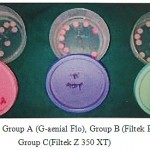 |
Figure 1: Group A (G-aenial Flo), Group B (Filtek P 90), Group C(Filtek Z 350 XT) |
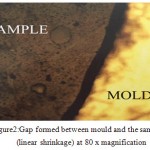 |
Figure 2: Gap formed between mould and the sample (linear shrinkage) at 80 x magnification |
Results
To test whether mean values of different groups differ from one another, ANOVA has been used. The five measurements were taken per sample before and after tooth brush wear.
The average shrinkage of the three groups stand apart from one another significantly with the p- value less than (<0.05) amongst three groups. Polymerization shrinkage found to be very low in P 90 Mean value of (0.293) and higher in Filtek Z 35092.725) and highest in G-Aenial flo (4.350) [Table 1] [Figure 3].
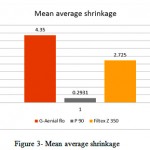 |
Figure 3: Mean average shrinkage |
Table 1: Mean values of polymerization shrinkage, roughness, wear
| Polymerization
Shrinkage |
Roughness | Wear | |||
| Before
Tooth brushing |
After
Tooth brushing |
Before
Tooth brushing |
After
Tooth brushing |
||
| Group A- G-aenial flo | 4.3500 | 0.2093 | 0.6520 | 0.2310 | 0.2307 |
| Group B-
Filtek P90 |
0.2931 | 0.4403 | 1.6990 | 0.2660 | 0.2657 |
| Group C-
Z350 XT |
2.7250 | 0.2890 | 1.4610 | 0.2655 | 0.2653 |
The comparision of toothbrush wear between the three groups G-Aenial flo showed significantly more wear with p value (<0.05) compared to other two groups and no statistically significant difference seen between P 90 and Filtek Z 350 [Figure 5]
The average roughness before wear found to be higher with P-90 with P- value (<0.05) when compared with G-Aenial flo and Filtek Z 350.There was no significant difference found between G=Aenial flo and Filtek Z350. [Figure 5]
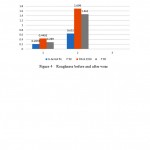 |
Figure 4: Roughness Before And After Wear |
Roughness after wear found to be significant lower in G-Aenial flo with P-lue (<0.05) compared to P-90 and Filtek Z350 .And no significant difference was found between P-90 and Filtek Z 350.[Figure 4]
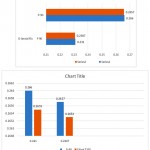 |
Figure 5: Wear Before and After |
Discussion
Composites have progressed from macrofill to microfill and from hybrids and newer fillers such as nanohybrid ,true nano, nanoclusters composites have been introduced into the market [7,8].
When the resin composite undergoes setting, the polymerization shrinkage induces contraction stress .The magnitude of the shrinkage and stress generated by the polymerization of the resin composite are the main factors for the in vivo problem like post operative sensitivity, poor marginal adaptation and recurrent caries .Polymerization shrinkage depends upon many factors such as load ,type of filler particles and monomer systems[9] .
In composite resins with particles ranging from 0.002 to 0.04µm are classified as microfills in this 50 5 of the volume of the material is resin [10] .Microhybrid composite resins contain particles ranging from 0.6-1 µm are developed [11] .New composite resins introduced in the market were developed using nano particles technology called nanomers with average particle size ranging from 20-75nm and nano clusters containing silica and zirconia particles interlinking reaching the mean size of 0.6µm which has surface finish of microfills without compromising the physical properties [12] . Surface roughness property of any material occurs when multiple factors such as filler type, shape, size and distribution of filler particles interact with one another . The aesthetics and clinical properties of composite resin depend not only on their structure but also on the surface roughness after tooth brushing which helps in greater longevity of the restoration the surface roughness of the resin may affect bacterial plaque retention [13] and evolve into periodontal diseases [12-14] .The restoration will appear optically smooth when the surface roughness value is smaller than 0.1µm [15] .
Polymerization shrinkage was recorded after 24 hours by using stereomicroscope .Filtek P -90 (Group B) had a statistically lower values of polymerization shrinkage as compared to G-Aenial flo (Group A) and Filtek Z 350 (Group C) [Figure 2,3].Silorane is the new type of monomer which is used in in Filtek P 90 ‘Silorane’ and it is conventional methacrylate composite resins .When compared to methacrylate composites the cycloaliphatic oxirane functional groups account for low shrinkage of siloranes. Oxiranes which are cyclic ethers polymerize via a cationic ring opening mechanism ;on the other hand methacrylate polymerize via free radical mechanism and P-90 by additional polymerization.[16,17] In this the terminal end of the polymer acts as a reaction centre where further cyclic monomers join to form a larger polymer chain through ionic propagation[18] . The cure process is initiated with electron donor assisting the oxidation reduction mechanism and degrading the idonium salt to acidic cation which starts the ring opening polymerization process. After the addition of oxirane monomer the epoxy resin is opened to form a chain or in the case of two or more multifunctional monomers a network [19]. Polymerization shrinkage did not start immediately after light exposure but an expansion occurred instead it took long time to gel and reach vitrification point. Vitrification is a phenomenon completely distinct from gelation .It occurs after gel point when the elastic gel transform to a glass. Being slower to polymerize more time is allowed for the matrix to flow. This meant that silorane has the highest potential for stress release by permitting the material to flow during initial curing stage .G-Aenial flo (Group A ) showed the highest shrinkage value amongst all the groups .As the filler load present in G=Aenial flo is less compared to the other two groups it has the high shrinkage values.
The use of prophylactic home procedures results in rough surface of restorative materials thereby causing bacterial adhesion and colonization . During tooth brushing the tooth paste is quickly diluted by saliva, in experiments in vitro this effect is stimulated by diluting the tooth paste with distilled water [20-22] .
Surface roughness (Ra) before wear in this study was recorded using surface profilometer (MITUTOYA, Japan).Surface polishing was done using soflex discs for 1 minute ( finishing disc and polishing disc).As it is proved that surface created against the polyester matrix is rich in monomers and less resistance to abrasion. All the samples were air dried to make the samples free of contamination and the roughness was recorded by the help of a diamond probe (0.1µ).The roughness of the samples were recorded in (Ra ) value. After tooth brush wear of the composite were recorded using surface profilometer (Mitutoya ,Japan).In the present study the surface roughness of G-Aenial flo (Group –A) had significantly low (Ra) value before and after wear followed by Filtek P 90 (Group –B)Filtek Z 350 (Group C)
This significant difference in the roughness of three groups is due to different filler type, filler load and filler distribution used in this resin .The nanofillers used in G-Aenial Flo significantly improved the reduction of surface roughness leading to better polish and gloss than microhybrid composites .The larger filler particles in (Group B) resulted in more roughness [Figure 4].
Amongst the important factors of clinical success of composite resins wear of composite resin also play an important role .However there is a documentation that wear is improved by increasing the filler load and decreasing the particle size [23].The nanocluster filled (Filtek Z350 XT) composite resin have showed significantly least wear when compared with convention microhybrid composite (Filtek P90) due to improvement in the filler load of the composite [24,25] [Figure 5].Nanocluster formulations reduce the interstitial spaces of the filler particles and increase the filler load which improves the wear. The flowable composite (G-Aenial flo, true nano filler composite )(Group A) have statistically more wear than high filled composites ,micro hybrid (Group B) and nano clusters (Group C) due to reduced filled load .
Conclusion
Within the limitations of the study
Statistical significant variation is there among the groups in relation to shrinkage with G-Aenial flo having maximum shrinkage and Filtek p 90having the least
No statistical significant difference between Filtek P90 and Filtek Z350 XT in relation to wear with G-Aenial flo showing the maximum value
G-Aenial flo performed better in relation to roughness as compared to Filtek P90 and Filtek Z 350 XT
In relation to roughness ,statistical significant difference is there between Filtek P-90 and Filtek –Z350 XT with Filtek P-90 showing maximum value
References
- Peutzfeldt A. Resin composites in dentistry :the monomer systems .European J.Oral sciences 1997;105:97-116.
CrossRef - A.Subbiya, N.Gold Pearlin Mary, Malathi Suresh, P. Vivekanandhan, D.Malarvizhi, V.G.Sukumaran. Comparison of the variation in the light curing cycle with a time gap and its effect on polymerization shrinkage, degree of conversion and micrhardness of a nanohybrid composite. J Conserv Dent 2015; 18: 154-158.
CrossRef - Beun S,Glorieux T,Deavux J,Vreven J,Leloup G.Characterisation of nanofilled compared to universal and microfilled composites .Dental materials 2007;23(1):51-9.
CrossRef - Weinmann W,Thalaker C,Guggenberger R,Siloranes in dental composites 2005;21:68-74
- Quirynen M1, Bollen CM, Papaioannou W, Van Eldere J, van Steenberghe D. The influence of titanium abutment surface roughness on plaque accumulation and gingivitis: short-term observations. Int J Oral Maxillofac Implants. 1996 Mar-Apr;11(2):169-78.
- Neme AL1, Frazier KB, Roeder LB, Debner TL Effect of prophylactic polishing protocols on the surface roughness of esthetic restorative materials Oper Dent. 2002 Jan-Feb;27(1):50-8.
- SD Heintze • M Forjanic Surface Roughness of Different Dental Materials Before and After Simulated Toothbrushing In Vitro Operative Dentistry, 2005, 30-5, 617-626
- Juergen manhart dds, Dr med dent* and Reinhard hickel DDS Esthetic Compomer Restorations in Posterior Teeth Using a New All-in-One Adhesive: Journal of Esthetic and Restorative Dentistry 1999; 11:250-258.
CrossRef - C M Bejoy Mony, B Hemasathya, Suresh Mitthra. Perception and pro-prioception in relation to masticatory act. Biomedical and pharmacology journal 2015; 8 (Special issue Oct) :149-154.
- B.A.M. Venhoven and others, “Influence of filler parameters on the mechanical coherence of dental restorative resin composites”, Biomaterials,1996; 17(7): 1996, pp. 735-740.
- Attar N1, Turgut MD. Fluoride release and uptake capacities of fluoride-releasing restorative materials Oper Dent. 2003 ;28(4):395-402.
- Cornelis J. Kleverlaan, Albert J. Feilzer Polymerization shrinkage and contraction stress of dental resin composites. Dent Materials 2005; 21: 1150–1157.
CrossRef - Anne Peutzfeldt*Resin composites in dentistry: the monomer systems.European Journal of Oral Sciences 1997;105: 97–116.
CrossRef - Cemal Yesilyurt, Oguz Yoldas, Subutay han Altintas, Adem Kusgoz. Effects of food-simulating liquids on the mechanical properties of a silorane-based dental composite Dental Materials Journal 2009; 28(3):362-7.
CrossRef - Chen HY1, Manhart J, Hickel R, Kunzelmann KH. Polymerization contraction stress in light-cured packable composite resins. Dent Mater. 2001;17(3):253-9.
CrossRef - Bagis YH1, Baltacioglu IH, Kahyaogullari Comparing microleakage and the layering methods of silorane-based resin composite in wide Class II MOD cavities. Oper Dent. 2009 ;34(5):578-85.
CrossRef - Weinmann W1, Thalacker C, Guggenberger R. Siloranes in dental composites Dent Mater. 2005;21(1):68-74.
CrossRef - Palin WM1, Fleming GJ, Nathwani H, Burke FJ, Randall RC. In vitro cuspal deflection and microleakage of maxillary premolars restored with novel low-shrink dental composites. Dent Mater. 2005;21(4):324-35.
CrossRef - Juliana da costa dds, ms1,*, Jack ferracane phd2, rade d. Paravina dds, ms, phd3, Rui fernando mazur dds, ms, phd4 Adleslie roeder dds, MS5The Effect of Different Polishing Systems on Surface Roughness and Gloss of Various Resin Composites Journal of Esthetic and Restorative Dentistry 2007;19(4): 214–224.
- M Jung • K Sehr • J Klimek N Surface Texture of Four Nanofilled and One Hybrid Composite After Finishing Operative Dentistry, 2007; 32: 45-55.
- Rosana Aparecida PereiraI; Paulo Amarante de AraujoII; Juan Carlos Castañeda-EspinosaIII; Rafael Francisco Lia MondelliIV Comparative analysis of the shrinkage stress of composite resins. J. Appl. Oral Sci. 2008; 16 :36-44.
- Attar N. The Effect of Finishing and Polishing Procedures on the Surface Roughness of Composite Resin Materials. J Contemp Dent Pract 2007;(8)1:27-35.
- R. Mensudar, A. Karthick, D. Amudha, Dr.Aparna Dash.Use of innovative megafillers for improving the marginal adaptation of composite restoration. Indian Journal of Multidisciplinary Dentistry 2011;1(4):186-189.
- C. R. Perez, R. Hirata Jr, A. H. M. F. T. Silva, E. M. Sampaio, and M. S. Miranda . Effect of a Glaze/Composite Sealant on the 3-D Surface Roughness of Esthetic Restorative Materials. Operative Dentistry 2009; 34: 674-680.
CrossRef - Korkmaz Y1, Ozel E, Attar N, Aksoy G.The influence of one-step polishing systems on the surface roughness and microhardness of nanocomposites. Oper Dent. 2008;33(1):44-50.
CrossRef

This work is licensed under a Creative Commons Attribution 4.0 International License.





